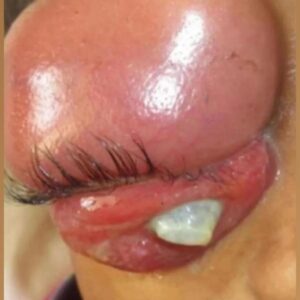Reduced range of motion and discomfort are possible effects of frozen shoulder. What are the best treatment alternatives for the most at-risk individuals?
Simon Perry, a 47-year-old man with hypothyroidism, did not remember getting hurt until he realized that extending his left arm caused some minor discomfort. A mere ten weeks later, he found himself at his physician’s office, his shoulder uncomfortable and tight that he refrained from using his arm.

“I never knew about frozen shoulder until I Googled my symptoms,” Perry explains. “It’s one of those things you’ve not heard of, but once you mention it to others, chances are they’ve either had it or know someone who has.”
Frozen shoulder (FS), mostly in women between the ages of 40 and 60, affects five to twenty percent of persons, according to the orthopedics department of the University of California, San Francisco. Even the translation of its Japanese name is “50-year-old shoulder.”
Known medically as adhesive capsulitis, it is made more difficult by discrepancies in scientific research and disagreements among medical experts over the most effective course of treatment.
Patients encounter varying combinations and intensities of symptoms, which might arise gradually or suddenly following an injury, surgery, inactivity, or even nothing at all. Shoulder discomfort that lasts more than three months usually begins with FS and worsens gradually. It normally hurts worse at night, interfering with sleep, especially when the arm is moved.
The range of motion (ROM) of the joint gradually decreases, becoming more painful and stiff until the patient can hardly move their arm. Fibrosis, a thickening of the tissues within the joint capsule that causes it to contract and reduce mobility, is the cause of the stiffness.
The non-dominant arm is typically impacted, and external rotation is typically the first motion to be hampered. As it worsens, the range of motion in all directions may be significantly restricted, which may affect daily activities and job. Assistance may even be needed for dressing and taking a shower.
Perry states, “I had trouble sleeping on my left side a few months after the symptoms started. I had very little and weak movement in my left arm. It hurt so bad. My physical interactions with my children decreased as a result. I was limited to using my right hand for grocery shopping and showering. Heat and cold packs were ineffective.
FS typically lasts 30 months and advances in three stages:
1. Freezing (2–9 months): As the shoulder capsule tightens and range of motion reduces, pain due to inflammation takes center stage.
2. Frozen (usually 4–12 months): discomfort associated to inflammation usually goes away, but stiffness stays.
3. Thawing (12–42 months): As the joint progressively relaxes, range of motion increases.
Not everyone goes through every stage, and development can vary.
The diagnosis of FS is made based on clinical symptoms, medical history, ROM physical tests, and imaging to rule out other possible causes, such as rotator cuff injuries, even though there is no specific test for the condition. In order to rule out impingement, an anesthetic injection into the shoulder joint is occasionally utilized as a diagnostic tool.
Although the exact cause of FS is unknown, research has shown that people who have:
1. Diabetes has a 10–20% lifetime risk and increases the chance of affecting both shoulders at once.
2. Damage to the shoulder joint causing immobilization or decreased range of motion
3. Issues with the thyroid, in particular hypothyroidism
4. A stroke
5. Heart conditions
6. Elevated cholesterol levels in the blood
7. Dupuytren’s illness
8. Parkinson’s illness
9. Cancer
Approximately 75% of patients with frozen shoulder that Dr. Allan Mishra treats at Stanford University are female. He is an adjunct clinical associate professor of orthopedic surgery. Menopause-related hormonal changes might contribute to [its] development. Hormonal therapy may lower the likelihood of developing FS, according to some data, although further research is required to validate these findings. Additionally, diabetic patients are more likely to experience more severe and protracted instances.”
“Fasting glucose testing may be considered [in those patients with FS] given the high prevalence of diabetes and prediabetes in patients with adhesive capsulitis,” agrees Theresa Marko, a physical therapist and representative for the American Physical Therapy Association (APTA).
It’s critical to seek therapy and continue using the arm as long as the pain permits. According to a paper published in 2021, FS can last longer than three years and never go away on its own.
According to Mishra, “To treat frozen shoulder, a combination of treatments is usually used.” These include of applying heat, stretching, and anti-inflammatory drugs. Patients who do not respond to early treatment may require injection therapy. Surgery is rarely necessary to fully treat the problem.”
Marko states, “A physical therapist will conduct a comprehensive assessment, identify the stage you are in, and develop a customized treatment plan. The program’s goal is to recover your movement and will be customized to meet your individual needs.”
Physiotherapy (PT) is one form of non-surgical treatment:
1. Supportive management (freezing stage) – analgesics, heat/ice packs, gentle range-of-motion exercises, hands-on therapy.
2. Structured PT (frozen and thawing stages) – stretching and strengthening exercises, manual therapy.
3. Corticosteroid injections (if PT alone is ineffective) – administered into the joint, give short-term improvements compared with no treatment; a combination of injections and PT show limited improvements compared to either alone.
The American Academy of Family Physicians advises consulting an orthopedic surgeon for individuals who have unbearable symptoms and show only modest improvement following 6–12 weeks of conservative treatment. Options for surgery are:
· The process of hydrodilatation involves injecting a mixture of saline, corticosteroid, and anesthetic to enlarge the joint. Limited research has yielded inconsistent efficacy findings.
· Arthroscopic capsular release (ACR): This type of keyhole surgery involves severing the tight tissues surrounding the shoulder to release it.
· Manipulation under anesthesia (MUA): this type of surgery involves manipulating the shoulder to release and stretch tissues that have become taut.
Researchers found in 2022 that at three months, ACR outcomes were inferior to those of PT combined with MUA or corticosteroid injection. None was clinically superior at 12 months, but ACR posed a greater risk than MUA.
Perry had physical therapy after taking Ibuprofen to lessen discomfort and swelling. The physiotherapist reduced the exercises to just one movement when the patient’s pain prevented him from completing any of them.
In his opinion, PT had no impact. A corticosteroid injection was given to him by an orthopedic physician who was referred to him. “Within days, my ROM improved by fifty percent, and within the next few months, most of the rest came back,” remarked the doctor. Perry reports no pain in his shoulder three years later, though he doubts he has regained complete range of motion.
After recuperation, 10% of FS patients still experience pain and stiffness. While FS recurrence in the same joint is uncommon, up to 20% of individuals may get the condition in the opposite joint, according to medical writers writing in 2022.
In their 2021 review, researchers postulated that, in contrast to the arms’ natural evolutionary function, today’s sedentary lifestyles and decline in manual labor, especially among women, have resulted to an underuse of the arms, leading in weakness, lower-than-intended ROM, and a propensity for developing FS.
The obvious way to keep shoulders healthy is to keep them muscular and use their entire range of motion. According to Mishra, “[FS] can be avoided by performing a regular program of stretches. Using a heating pad to keep your shoulder warm over the winter may also help stop the illness from developing.”
“I always recommend a stretching routine, especially as you age,” Marko asserts. “Having that established beforehand can’t hurt, even though it might not prevent FS. If you have previously experienced FS, your physical therapist will likely provide maintenance advice and ensure that you have received updated blood and hormone work from a PCP.”
Take three daily breaks to complete each workout to prevent or treat FS. Relentless work ethic is the secret to progress. See your doctor before beginning any workout regimen:
1. Shoulder Circles
· Bend over at your waist. Put the opposite hand on a table or countertop
· Let your arm dangle, then rotate it ten times clockwise
· Then, rotate it ten times in a counterclockwise direction
2. Shoulder Blade Squeezes
· Squeeze your shoulder blades together slowly
· Release and repeat five times
3. Touchdowns
· Hold a light stick (broomstick or golf club) with both hands
· Start with hands on the stick at waist level
· Slowly raise the stick to eye level with your elbows straight
· Use your unaffected arm to help raise your affected arm
· Repeat five times


